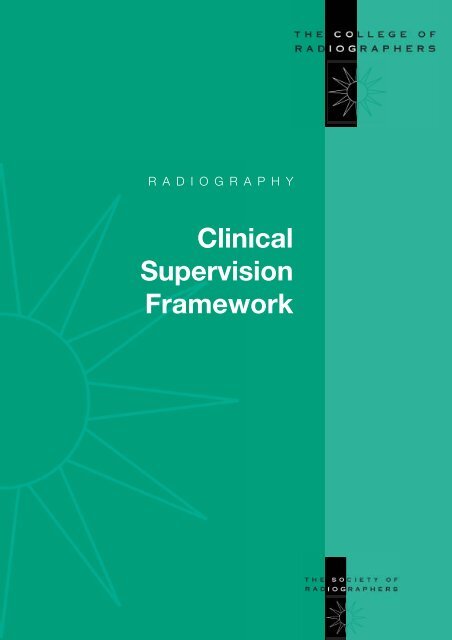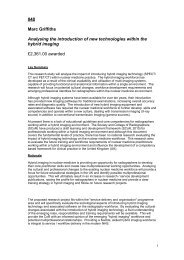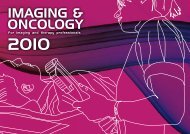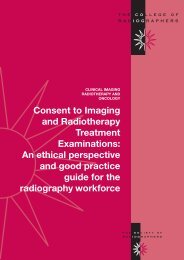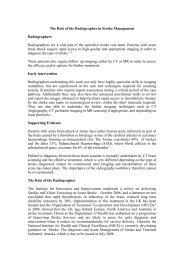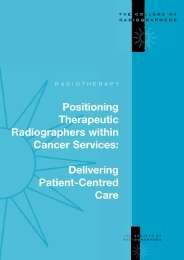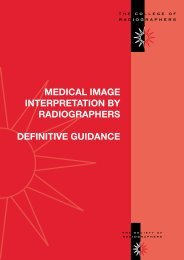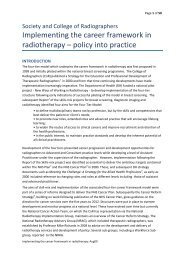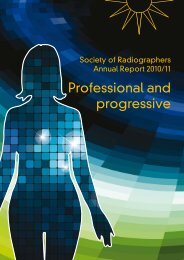Clinical Supervision Framework - Society of Radiographers
Clinical Supervision Framework - Society of Radiographers
Clinical Supervision Framework - Society of Radiographers
- No tags were found...
Create successful ePaper yourself
Turn your PDF publications into a flip-book with our unique Google optimized e-Paper software.
R A D I O G R A P H Y<strong>Clinical</strong><strong>Supervision</strong><strong>Framework</strong>
R A D I O G R A P H Y<strong>Clinical</strong> <strong>Supervision</strong> <strong>Framework</strong>College <strong>of</strong> <strong>Radiographers</strong>’ Responsible Officer:Sue ShelleyFirst editionMarch 2003ISBN 1 871101 02 6£15 SCoR members£25 non-membersThe College <strong>of</strong> <strong>Radiographers</strong>207 Providence SquareMill StreetLondon SE1 2EWTelephone 020 7740 7200Facsimile: 020 7740 7233E-mail: info@sor.orgWebsite: www.sor.org3
ContentsIntroduction 5What is Preceptorship? 6What is Mentorship? 6<strong>Clinical</strong> <strong>Supervision</strong> 7Key Principles <strong>of</strong> <strong>Clinical</strong> <strong>Supervision</strong> 7The SCoR Model <strong>of</strong> <strong>Clinical</strong> <strong>Supervision</strong> 8<strong>Clinical</strong> <strong>Supervision</strong> – Implementation 9Guidance on the Responsibilities for Supervisors, Supervisees and the Employer 9Conclusion 10References and Bibliography 104
IntroductionThe purpose <strong>of</strong> this paper is to take forward for the pr<strong>of</strong>ession the concept <strong>of</strong> clinicalsupervision and provide guidance on its implementation as part <strong>of</strong> continuing pr<strong>of</strong>essionaldevelopment and life-long learning.<strong>Clinical</strong> supervision describes a structured process <strong>of</strong> pr<strong>of</strong>essional support and learningthat enables individual practitioners to develop knowledge and competence, assumeresponsibility for their own practice and enhance consumer protection and the safety <strong>of</strong>care in complex clinical situations. It focuses upon the reflective learning processenabling the expansion <strong>of</strong> the scope <strong>of</strong> practice through self-assessment anddevelopment <strong>of</strong> enhanced analytical and reflective skills.Many radiographers will be familiar with the notion <strong>of</strong> clinical supervision as it is alreadypart <strong>of</strong> their current practice but evidence suggests that this is on an ad-hoc basis asopposed to being formalised. Many other healthcare pr<strong>of</strong>essions have successfullyembedded clinical supervision as a method <strong>of</strong> developing a deeper understanding <strong>of</strong> howtheory and practice are inter-related. <strong>Clinical</strong> supervision is a powerful tool forradiographers to share experiences and to learn from those clinical practice experiences,so allowing enhanced practice development.The term ‘clinical supervision’ in the past for radiography has been used to describe therelationship with students or sub-ordinates. It is important, therefore, that the use <strong>of</strong> theterm along with its revised description is contextualised in line with current health andsocial care policy. <strong>Clinical</strong> supervision is a theme that runs through Government guidanceon continuing pr<strong>of</strong>essional development and in relation to clinical governance.In order to bring some clarity to related terms and definitions the following glossary maybe useful:● Appraisal - quality assessment <strong>of</strong> an individual’s work● <strong>Clinical</strong> supervision - an exchange between practising pr<strong>of</strong>essionals to enable thedevelopment <strong>of</strong> pr<strong>of</strong>essional knowledge and skills● Mentorship - support <strong>of</strong>fered by an experienced pr<strong>of</strong>essional nurturing and guidingthe novice● Peer review - feedback and evaluation on decision processes by a peer or peers● Performance review - regular assessment <strong>of</strong> an individual’s work performance● Preceptorship - period <strong>of</strong> adaptation into a new role.Of the above, preceptorship and mentorship are important in the context <strong>of</strong> clinicalsupervision and are described in more detail in the following sections.5
What is Preceptorship?The philosophy <strong>of</strong> preceptorship is to enable the newly qualified radiographer practitionerto consolidate knowledge (educative), to be inducted into the policies and procedures <strong>of</strong>the workplace (normative) and to reflect on their practice, especially on challengingexperiences (restorative). At the end <strong>of</strong> the preceptorship period registered pr<strong>of</strong>essionalsshould feel confident about engaging with regular clinical supervision throughout theircareers, and with mentorship form time to time as appropriate. The aim <strong>of</strong> thepreceptorship period is to introduce and promote independence and confirm good clinicalpractice in a variety <strong>of</strong> situations and settings.During the period <strong>of</strong> preceptorship it is expected that radiographers and assistants willwork with their preceptor for a specific period <strong>of</strong> time during the working week. Theperiod <strong>of</strong> preceptorship is not time limited but is the subject <strong>of</strong> a learning agreement thatsets out mutually agreed goals in relation to decision making and know how in thecontext <strong>of</strong> departmental protocols for clinical imaging/treatment delivery and patient care.Preceptorship will end when preceptor, registered practitioner and manager agree thatgoals have been attained. This whole process is incorporated into the performancemanagement systems already in place within departments.Additionally within an individual’s career development there will be other discrete pointswhen additional more structured arrangements for ‘supervision’ may be required, forexample when more mature staff undergo role transitions/development they may alsorequire more support in the form <strong>of</strong> a period <strong>of</strong> preceptorship, where as between thesecareer-change times the less formal arrangement <strong>of</strong> mentorship is more appropriate.What is Mentorship?The philosophy <strong>of</strong> mentorship is concerned with making the most <strong>of</strong> "human potential"and encouraging self-development. It is a less structured process and relies more on theactive seeking out and challenging <strong>of</strong> practice concepts with either a peer or othermembers <strong>of</strong> the team. Mentorship is a tool <strong>of</strong>ten employed for developing managers andas such this may be particularly beneficial for those newly appointed to consultant ormanagement posts.Preceptorship and mentorship may be viewed as complementary to and integral toclinical supervision. However clinical supervision skills need to be developed so that allstaff can engage with it and also develop the skills required to supervise other staff asappropriate.6
<strong>Clinical</strong> <strong>Supervision</strong>Before describing clinical supervision, it is useful to review the term ‘direct clinicalsupervision’ that has been used in radiography for many years.‘Direct clinical supervision’ is a term used to describe a radiographer who is workingunder the direct clinical supervision <strong>of</strong> a senior or superintendent radiographer. While thisdefinition is helpful in situations where individuals may require close supervision in relationto specific tasks, it is only an element <strong>of</strong> clinical supervision and not the whole entity.<strong>Clinical</strong> supervision embraces all <strong>of</strong> the strands <strong>of</strong> preceptorship, mentorship and attimes direct clinical supervision. It helps to support the cultural changes required forlife–long learning and incorporates the essential principles <strong>of</strong> CPD to facilitatepr<strong>of</strong>essional and practice development and growth.Key Principles <strong>of</strong> <strong>Clinical</strong> <strong>Supervision</strong><strong>Clinical</strong> supervision is a formalised means <strong>of</strong> improving and monitoring practice. It aimsto improve skills, provide insights and improve patient care using a structured relationshipthat involves regular interaction with a more skilled and experienced practitioner but notnecessarily a more senior person. The success <strong>of</strong> clinical supervision is dependent upondeveloping a culture where staff contributions are valued in relation to providingservice/patient, individual and pr<strong>of</strong>essional benefits.The Department <strong>of</strong> Health’s vision <strong>of</strong> continuous quality improvement and the introduction<strong>of</strong> clinical governance, including arrangements for accreditation <strong>of</strong> clinical services, restsupon a clear commitment to evidence-based practice and the use <strong>of</strong> protocols. Achievingthis requires appropriate development <strong>of</strong> the workforce through education and training,CPD and life-long learning and the key principle that underpins this is reflective practiceand its use in developing and supporting practice development.<strong>Clinical</strong> supervision supports all <strong>of</strong> the above and rests upon the following key principles:● It narrows or eliminates the practice/theory divide through the development andenhancement <strong>of</strong> radiographers’ reflective skills● It involves a supervisor and a radiographer engaging in a process to facilitate reflection● It is an inclusive not exclusive process from which all staff benefit● It is confidential to the specific people engaged in the supervision● It is flexible and <strong>of</strong>fers choice in the model <strong>of</strong> clinical supervision used, for exampleboth individual and group supervision is possible● It requires support and needs to be adequately resourced in line with it being a keypart <strong>of</strong> an organisations quality agenda● It requires a system for training both supervisors and supervisees● It complements and supports other CPD/life-long learning planning or activities● It needs to be regularly reviewed with the potential for audit.Continued over....7
Importantly clinical supervision fosters a culture <strong>of</strong> openness and puts the patient’sneeds at its centre. It <strong>of</strong>fers a structured way <strong>of</strong> ensuring that those engaged inradiography are able to meet current and future practice challenges. This is particularlyrelevant in roles where increasing autonomy and greater degrees <strong>of</strong> decision making forma significant part <strong>of</strong> those roles. It is also a mechanism to ensure that, during prolificexpansion <strong>of</strong> radiographers’ roles and responsibilities combined with rapidly increasingservice pressures, that practice standards are not compromised.The need for clinical supervision to be embedded in our clinical practice has gatheredmomentum since the publication <strong>of</strong> the Kennedy Report. This combined with on-goingchanges in the structure <strong>of</strong> the pr<strong>of</strong>ession, the current demands on our radiographersdue to increasing service pressures and staffing shortages, are exacerbating stress levels,particularly at the ‘sharp-end’ <strong>of</strong> clinical practice. <strong>Clinical</strong> supervision <strong>of</strong>fers a way toprovide the necessary support for staff. It also has a central role in supporting thedevelopment <strong>of</strong> practice innovation and its systematic evaluation.In summary, clinical supervision is a tool that enables practitioners and others to developtheir skills and abilities to their full potential hence contributing to their job satisfaction. Itenables radiographers to accept full responsibility and accountability for their ownpractice and to subsequently feel empowered and confident to challenge systems andprocedures that underpin practice. To ensure that radiographers continue to provide highquality care and to develop their clinical practice, the culture in practice settings needs todevelop to reflect the importance <strong>of</strong> engaging with clinical supervision.The SCoR Model <strong>of</strong> <strong>Clinical</strong> <strong>Supervision</strong>There are many models <strong>of</strong> clinical supervision. However the model proposed in theEducation and Pr<strong>of</strong>essional Development Strategy is based upon the three threefunctions formative, normative and restorative that indicates the educational, supportiveand pr<strong>of</strong>essional monitoring roles <strong>of</strong> the supervisor.Within this context clinical supervision relates to a support mechanism for individualpractitioners, however, it is not a managerial control system. It is equally applicable to allgrades and types <strong>of</strong> staff working within the service throughout their working life.8
<strong>Clinical</strong> <strong>Supervision</strong>-ImplementationAs stated earlier ‘supervision’ in radiography may for many radiographers be associatedwith the radiographer/student relationship. However, to release the true potential <strong>of</strong>practitioners it is essential that we all engage in clinical supervision in its broader sense.The aims <strong>of</strong> clinical supervision in this broader sense are summarised as follows.<strong>Clinical</strong> supervision:● Safeguards standards <strong>of</strong> practice● Develops individuals, both pr<strong>of</strong>essionally and personally● Promotes excellence in health careA key feature <strong>of</strong> clinical supervision is that <strong>of</strong> reflective practice whereby practitioners learnfrom reflecting on their everyday practice in a structured way that informs future practice.There are, however, employer commitments that need to be in place for clinicalsupervision to be successful, as indicated below:● Commitment at all levels <strong>of</strong> the organisation● Protected resources (time, budget, staffing and training)● Training for both supervisors and supervisees● <strong>Supervision</strong> for supervisors● Strategies related to implementation <strong>of</strong> clinical supervisionGuidance on the Responsibilities for Supervisors, Supervisees and EmployersIn introducing a system for clinical supervision the infrastructure that needs to be in placeis partly defined by the roles and responsibilities <strong>of</strong> each <strong>of</strong> the participants, these, alongwith the employer’s commitment and responsibilities, are outlined below:SupervisorsThe importance <strong>of</strong> the role <strong>of</strong> the supervisor in the success <strong>of</strong> clinical supervision cannotbe underestimated. As such, attention must be given to the selection and training <strong>of</strong> thisgroup <strong>of</strong> staff.Qualities required <strong>of</strong> the supervisor include that they should be:● Trustworthy● Honest about own limitations● Open● Active listeners● Supportive● Facilitative rather than directive● Analytical● Committed to giving supervision● Knowledgeable about radiography practice.Supervisees need to be:● Committed to clinical supervision● Empowered to select an appropriate supervisor● Open to suggestions● Prepared to put time and thought into the process● Able to acknowledge clinical supervision as a tool to develop competenceThe employer should ensure that it is:● Committed to clinical supervision at all levels● Resourcing the process adequately● Identifying and providing training as a priority● Clear about the demarcation between managerial and clinical supervision roles● Integrating standards for clinical supervision <strong>of</strong> radiographers into its wider governanceagendas.Continued over...9
ConclusionIn conclusion, for radiography to develop and flourish it is essential that the pr<strong>of</strong>essionengages with clinical supervision to facilitate pr<strong>of</strong>essional confidence building andleadership skills, autonomy and effective practice at all levels. As such, clinicalsupervision is an important developmental tool that needs to be embedded intoradiographers’ everyday practice.The SCoR is committed to supporting radiographers and their employers to developeffective clinical practice through clinical supervision. It recognises that this is a newconcept for some radiographers and that those individuals may need additional guidanceand support to implement clinical supervision. Such individuals are encouraged to makecontact with the pr<strong>of</strong>essional team <strong>of</strong> the SCoR on 0207 740 7224 to discuss theirparticular needs.References and BibliographyDepartment <strong>of</strong> Health (November 2000) Meeting the Challenge: A Strategy for the AlliedHealth Pr<strong>of</strong>essions. Department <strong>of</strong> HealthFaugier, J., Butterworth, C.A. (1993) Position Paper on <strong>Clinical</strong> <strong>Supervision</strong> Manchester:University <strong>of</strong> ManchesterNHS (September 2000) The NHS Cancer Plan: A Plan for investment; A Plan forreform.NHS.UKNHS Executive (1999) Continuing Pr<strong>of</strong>essional Development: Quality in the new NHSNHS ME (1993) A vision for the future. The nursing, midwifery and health visitingcontribution to health and social care, Department <strong>of</strong> HealthNHS. (July 2000) The NHS Plan: A Plan for investment, A Plan for reform.NHS.UKThe Bristol Royal Infirmary Inquiry (2001) The Inquiry into the management <strong>of</strong> care <strong>of</strong>children receiving complex heart surgery at the Bristol Royal Infirmary(http://www.bristol-inquiry.org.uk (accessed 29 Jan 2002)The College <strong>of</strong> <strong>Radiographers</strong> (1999) <strong>Clinical</strong> Governance Guidance for<strong>Radiographers</strong>, CORThe College <strong>of</strong> <strong>Radiographers</strong> (2000) A strategy for the education and pr<strong>of</strong>essionaldevelopment <strong>of</strong> therapeutic radiographers, CORThe College <strong>of</strong> <strong>Radiographers</strong> (2002) A strategy for the education and pr<strong>of</strong>essionaldevelopment <strong>of</strong> radiographers, CORThe College <strong>of</strong> <strong>Radiographers</strong> (2002) Interim Guidance for CPD, CORThe College <strong>of</strong> <strong>Radiographers</strong> (2002) Interim guidance on Implementing the <strong>Society</strong>and College <strong>of</strong> <strong>Radiographers</strong> Career Progression <strong>Framework</strong> in Radiography, SCoRThe College <strong>of</strong> <strong>Radiographers</strong> (2002) Statements for Pr<strong>of</strong>essional Conduct, CORThe Secretary <strong>of</strong> State for Health (1997) The New NHS: Modern and Dependable,HMSOThe Secretary <strong>of</strong> State for Health (1998) A First Class Service: Quality in the New NHS,HMSOUnited Kingdom Central Council for Nursing, Midwifery and Health Visiting (1995) PositionStatement on <strong>Clinical</strong> <strong>Supervision</strong> for Nursing and Health Visiting: UKCC LondonWhitley Councils for the Health Services (1991) Conditions <strong>of</strong> Service, HMSO10
The College <strong>of</strong> <strong>Radiographers</strong>Limited company registration number 1287383Registered charity number 272505First editionMarch 2003ISBN 1 871101 02 6£15 SCoR members£25 non-membersThe College <strong>of</strong> <strong>Radiographers</strong>207 Providence SquareMill StreetLondon SE1 2EWTelephone 020 7740 7200Facsimile 020 7740 7233E-mail info@sor.orgWebsite www.sor.org


